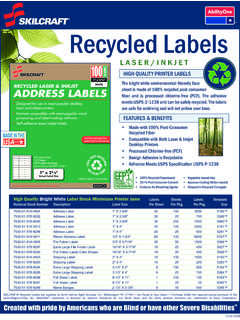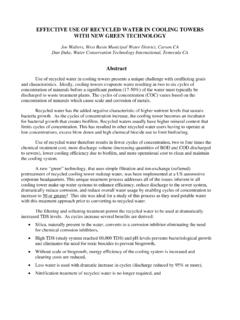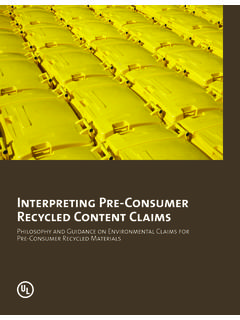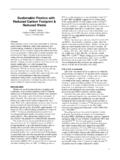Transcription of The Use of Recycled Glass in Concrete Technical …
1 The Use of Recycled Glass in ConcreteTechnical bulletin 110302 Introduction There are large amounts of Recycled Glass available for use in Concrete , but there have been many notable failures in concretes containing Recycled Glass due to unusual chemistries that occur when Glass is included in a Concrete mix.
2 This paper discusses these interactions and provides remedies to safely use Recycled Glass aggregates and some Glass powders in Concrete mix designs. First, some definitions: Concrete a mixture of cement, aggregates, water, and supplementary cementing materials (SCMs), also known as pozzolans. Pozzolan an amorphous (glassy) powdered siliceous material that responds to the alkali content in cements to react with lime in the high pH environment in Concrete to form additional CSH (calcium silicate hydrate) binder within the pore structure of the Concrete . Pozzolans are effective as minus 325 mesh powders. Pozzolans vary widely in reactivity, color, water demand, and in chemical composition. Much of the chemistry associated with certain pozzolans, such as sulfides, carbon, sulfates, and alkalis can be quite deleterious to the long-term durability of Concrete .
3 Recycled Glass comes from a variety of sources including curbside pickup, fiberglass factories, and other mixed Glass recycling centers. Glass has a chemistry that can be (a) soda lime Glass (bottles or windows) with 10-15% alkali content; (b) reinforcement fiberglass with 1% alkali content; or (c) borosilicate Glass (Pyrex) with 12% boron and 4% alkalis. Aggregates made from soda lime Glass can be used in Concrete if properly mitigated for ASR, as discussed later. Powders made from reinforcement fiberglass are excellent pozzolans. Borosilicates should never be put in Concrete due to their extreme expansion in Concrete environments. The wide range of chemistries found in common Recycled Glass is shown in Table 1. Alkalis are the sodium and potassium oxide (Na2O and K2O) constituents of Glass or cement that cause the pH in Concrete to reach or higher.
4 Alkalis, reacting with certain susceptible aggregates, are the main cause of ASR (alkali silica reaction), so many manufacturers Portland cements are sold as low alkali (less than alkali) to minimize ASR. Many white cements have alkali contents below Lime is the calcium hydroxide formed when water is added to Portland cement. More than 20% of the water + cement paste turns into lime. This lime is the primary source of efflorescence. ASR the alkali silica reaction, which causes an expansive silicate gel to form with reactive aggregates present in Concrete . Reactive aggregates include Glass , flint, chert, or certain rhyolites. The expansive force of the silicate gel is greater that the tensile strength of Concrete , so the Concrete will crack. Depending on the reactivity of the aggregate and the alkali content of the cement, cracking can occur as early as days, or it can be delayed for many months or even years later.
5 As cracking occurs, more water enters the interior of the Concrete to mobilize the alkalis present. In severe cases, over the years, ASR cracking can destroy the strength of the Concrete and ultimately reduce it to rubble. Vitro Minerals 9126 B Industrial Blvd, Covington, GA 30014 Phone: 678-729-9333 Fax:678-729-9336 - Table 1.
6 Chemical Composition of Recycled Glass Types SODA LIME SPECIALTY Consti-Container Window E- Glass Borosilicate Panel tuents (Bottle) (Float) (Fiber) (Pyrex) (TV) SiO2 Al2O3 CaO MgO Na2O K2O B2O3 Others*74 73 9 5 13 14 .. 0-2(a) 0-2(a)50-55 15-20 20-25 <1 <1 < 0-6 0-2(b)65-85 1-5 .. 3-9 0-2 8-15 0-1(c) 62-85 6-11 4-7 .. ~20(d) * (a) Fe2O3, Cr2O3, MnO2, TiO2, SO3; (b) Fe2O3, TiO2; (c) BaO; (d) BaO, SrO, Fe2O3, TiO2, CeO2, ZrO2, PbO, ZnO, As2O3, Sb2O3 CSH is calcium silicate hydrate, the main binder formed in Concrete when water is added to Portland cement. It either forms from the initial reaction of adding water to cement powder, or later from the reaction of a pozzolan with the lime also present in every Portland Concrete . The formation of CSH continues over a span of years as more cement hydrates or more pozzolan reacts.
7 As time passes, the Concrete becomes harder, denser, stronger, and is less porous. With the definitions out of the way, we can examine the issues of using Recycled Glass as aggregates or pozzolans in Concrete . General Pozzolan Information For a pozzolan to work to remediate ASR, it must be quite effective in powdered form (minus 325 mesh), and it must not bring unacceptable chemical constituents to the reaction. Deleterious chemical constituents include sulfides (turn Concrete green), sulfates (can cause delayed expansion), and alkalis (which add more alkali to Concrete which creates higher risk of ASR over the life of the Concrete ). A pozzolan can be thought of as a sacrificial anode, as it depolymerizes at the pH environment of freshly poured Concrete to go into solution to ultimately react with the lime in solution to form additional CSH binder.
8 The widely dispersed presence of the pozzolan will consume (sequester) the alkalis in Concrete such that the reactive aggregate remains untouched because of its larger particle size and the sacrificial characteristics of the pozzolan. A good pozzolan functions both to mitigate ASR and to consume the lime to greatly reduce efflorescence. This brings up the issue of pozzolan chemistries and sources. There are large amounts of mineral processing slags, coal fly ashes, Recycled glasses, and other amorphous materials that all undergo with varying effectiveness the pozzolanic reaction to react with the lime in Concrete . The problem is their level of effectiveness and the chemical constituents they introduce to the mix. For instance, most slags contain sulfides and have widely varying reactivities, and each must be individually tested to determine whether the side effects are acceptable.
9 Similarly, fly ashes vary widely in composition and fineness and many contain carbon, sulfates or lime, which may create undesirable effects in Concrete . Silica fume and metakaolin are widely used, but they have high water demands and greatly affect Concrete workability and placement rheologies. Recycled Glass as a Pozzolan The issue of Recycled Glass is quite complicated from a chemistry point of view (Table 1). Years ago, the reinforcement fiberglass manufacturers saw a large market potential in using Glass reinforcements as reinforcing fiber in Concrete . Early tests soon indicated that normal chemistry reinforcement fiberglass almost totally dissolved in the Concrete environment, as the extremely low alkali content of the fiber Glass , about 1%, caused it to be highly susceptible to alkalis in Concrete environments.
10 The fiberglass manufacturers were able to address the problem by adding 16% zirconia to the Glass chemistry to make it alkali resistant (so called AR Glass ). Borosilicate (Pyrex) type glasses are so expansive that they were selected to be the ASTM C441 test aggregate Vitro Minerals 9126 B Industrial Blvd, Covington, GA 30014 Phone: 678-729-9333 Fax:678-729-9336






